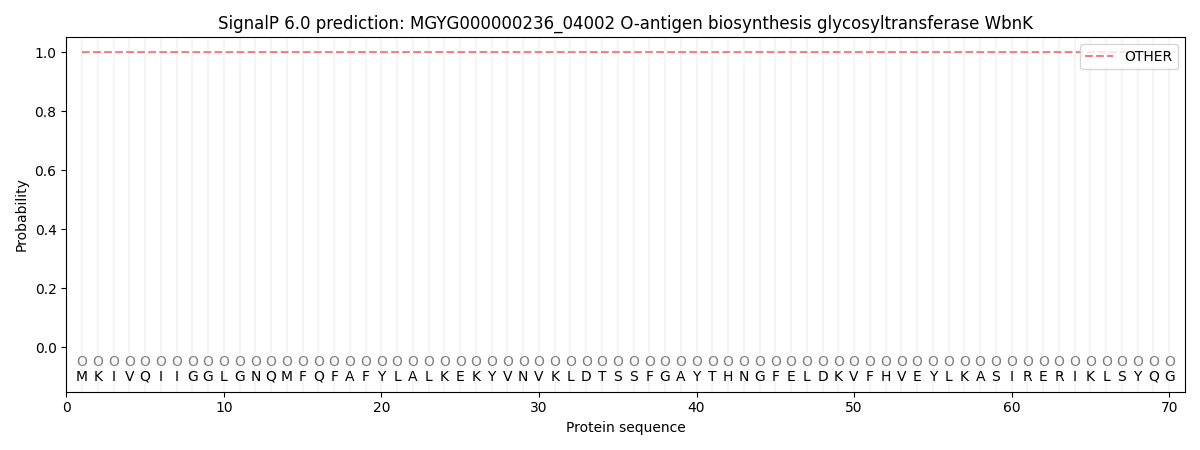You are browsing environment: HUMAN GUT
CAZyme Information: MGYG000000236_04002
You are here: Home > Sequence: MGYG000000236_04002
Basic Information |
Genomic context |
Full Sequence |
Enzyme annotations |
CAZy signature domains |
CDD domains |
CAZyme hits |
PDB hits |
Swiss-Prot hits |
SignalP and Lipop annotations |
TMHMM annotations
Basic Information help
| Species | Bacteroides fragilis_A | |||||||||||
|---|---|---|---|---|---|---|---|---|---|---|---|---|
| Lineage | Bacteria; Bacteroidota; Bacteroidia; Bacteroidales; Bacteroidaceae; Bacteroides; Bacteroides fragilis_A | |||||||||||
| CAZyme ID | MGYG000000236_04002 | |||||||||||
| CAZy Family | GT11 | |||||||||||
| CAZyme Description | O-antigen biosynthesis glycosyltransferase WbnK | |||||||||||
| CAZyme Property |
|
|||||||||||
| Genome Property |
|
|||||||||||
| Gene Location | Start: 51342; End: 52193 Strand: - | |||||||||||
CAZyme Signature Domains help
| Family | Start | End | Evalue | family coverage |
|---|---|---|---|---|
| GT11 | 2 | 281 | 6.6e-77 | 0.9855072463768116 |
CDD Domains download full data without filtering help
| Cdd ID | Domain | E-Value | qStart | qEnd | sStart | sEnd | Domain Description |
|---|---|---|---|---|---|---|---|
| cd11301 | Fut1_Fut2_like | 2.03e-72 | 1 | 278 | 1 | 265 | Alpha-1,2-fucosyltransferase. Alpha-1,2-fucosyltransferases (Fut1, Fut2) catalyze the transfer of alpha-L-fucose to the terminal beta-D-galactose residue of glycoconjugates via an alpha-1,2-linkage, generating carbohydrate structures that exhibit H-antigenicity for blood-group carbohydrates. These structures also act as ligands for morphogenesis, the adhesion of microbes, and metastasizing cancer cells. Fut1 is responsible for producing the H antigen on red blood cells. Fut2 is expressed in epithelia of secretory tissues, and individuals termed "secretors" have at least one functional copy of the gene; they secrete H antigen which is further processed into A and/or B antigens depending on the ABO genotype. O-fucosyltransferase-like proteins are GDP-fucose dependent enzymes with similarities to the family 1 glycosyltransferases (GT1). They are soluble ER proteins that may be proteolytically cleaved from a membrane-associated preprotein, and are involved in the O-fucosylation of protein substrates, the core fucosylation of growth factor receptors, and other processes. |
| pfam01531 | Glyco_transf_11 | 9.14e-26 | 108 | 281 | 125 | 295 | Glycosyl transferase family 11. This family contains several fucosyl transferase enzymes. |
| TIGR01612 | 235kDa-fam | 0.008 | 21 | 192 | 603 | 792 | reticulocyte binding/rhoptry protein. This model represents a group of paralogous families in plasmodium species alternately annotated as reticulocyte binding protein, 235-kDa family protein and rhoptry protein. Rhoptry protein is localized on the cell surface and is extremely large (although apparently lacking in repeat structure) and is important for the process of invasion of the RBCs by the parasite. These proteins are found in P. falciparum, P. vivax and P. yoelii. |
CAZyme Hits help
| Hit ID | E-Value | Query Start | Query End | Hit Start | Hit End |
|---|---|---|---|---|---|
| QCT75971.1 | 2.11e-216 | 1 | 283 | 1 | 283 |
| QRM68592.1 | 2.11e-216 | 1 | 283 | 1 | 283 |
| CAH09369.1 | 2.63e-216 | 1 | 283 | 7 | 289 |
| QLK80744.1 | 8.58e-216 | 1 | 283 | 1 | 283 |
| QCQ48037.1 | 8.58e-216 | 1 | 283 | 1 | 283 |
Swiss-Prot Hits download full data without filtering help
| Hit ID | E-Value | Query Start | Query End | Hit Start | Hit End | Description |
|---|---|---|---|---|---|---|
| Q58YV9 | 2.44e-32 | 8 | 281 | 7 | 300 | O-antigen biosynthesis glycosyltransferase WbnK OS=Escherichia coli OX=562 GN=wbnK PE=1 SV=1 |
SignalP and Lipop Annotations help
This protein is predicted as OTHER

| Other | SP_Sec_SPI | LIPO_Sec_SPII | TAT_Tat_SPI | TATLIP_Sec_SPII | PILIN_Sec_SPIII |
|---|---|---|---|---|---|
| 1.000052 | 0.000000 | 0.000000 | 0.000000 | 0.000000 | 0.000000 |
